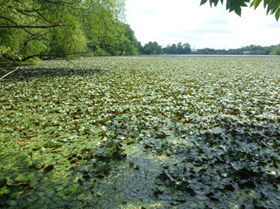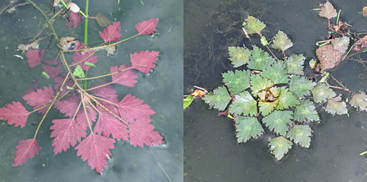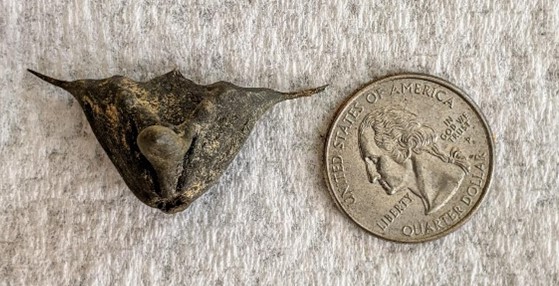Invasive Pests
Invasive pests (plants, insects, diseases, and others) cause enormous economic damage, as well as environmental damage. These displace or destroy beneficial and native plants and animals, reduce biodiversity. The annual economic cost is estimated at $1 billion in VA alone, more than $120 billion in the US.
If you think you see the following pest, which is not yet known to occur in Bedford County, please contact the Bedford Master Gardeners at bedfordmg@vt.edu or 540-586-7675. If you are outside of Bedford County, please contact your local Virginia Cooperative Extension Office.
Invasive Pest: Two-Horned Trapa (Trapa bispinosa) An Invasive Aquatic Plant

This invasive plant, native to China, Japan, Korea and Taiwan, was found in northern Virginia in 2014 and was first thought to be a new infestation of the water chestnut Trapa natans (also called the 4-horned trapa) which nearly blocked the Potomac River in the period from the 1930’s to the late 70’s. Removing it from that waterway required an extensive effort with an estimate $3.7 million cost. This new species has expanded rapidly in northern Virginia and lives in freshwater lakes, ponds, and slow moving water. It is documented in ponds in Fairfax, Prince William, Loudoun, and Fauquier Counties, as well as in the Potomac River. In 2022, it was found in a pond in Charlotte County, which may have occurred due to movement of equipment or water craft. (ref 1, 2, 4)

Two-horned trapa is an annual, floating aquatic plant with deltoid leaves that are green on top and red underneath. It produces a pink flower beginning in June and seeds until frost. Fruits are a large (2 inch) nut with two sharp spines. The plant dies back at the first frost. Seeds sprout the following spring (ref 1).
This invasive plant poses a serious threat to freshwater ecosystems. It forms mats that can entirely choke and cover ponds, shallow lakes, and slow moving channels. Its prolific growth shades out and competes with native submerged vegetation. It’s long roots and leaves decay each winter, reducing dissolved oxygen.

It is believed that large waterfowl like the Canada goose may help spread this plant, since the horned fruit can cling to feathers. Fruit also can attach to rope, clothing, boating gear and fur, all of which can contribute to the spread. The barbs on the seed are very sharp and can actually pierce gloves, hoes and skin. (1, 4).
Any reports of this pest need to be reported. The earlier an invasive species is discovered, the better the chances for eradication or suppression.
References (confirmed 5/7/2023)
- https://storymaps.arcgis.com/stories/05396b12d9384eb1a92f2bd66a19da64
- https://mdinvasives.org/%20iotm/july-2019/
- https://www.invasivespeciesva.org/species/two-horned-trapa
- https://www.dcr.virginia.gov/natural-heritage/document/fstrbi.pdf
Submitted by Betsy B., Bedford Extension Master Gardener and Help Desk Coordinator.